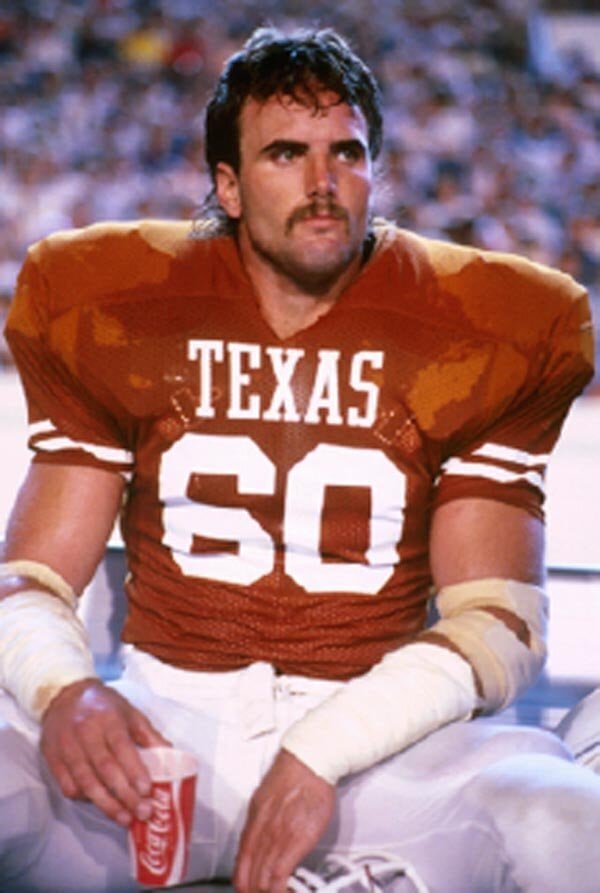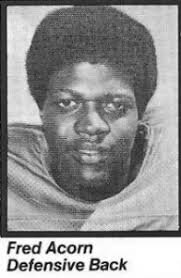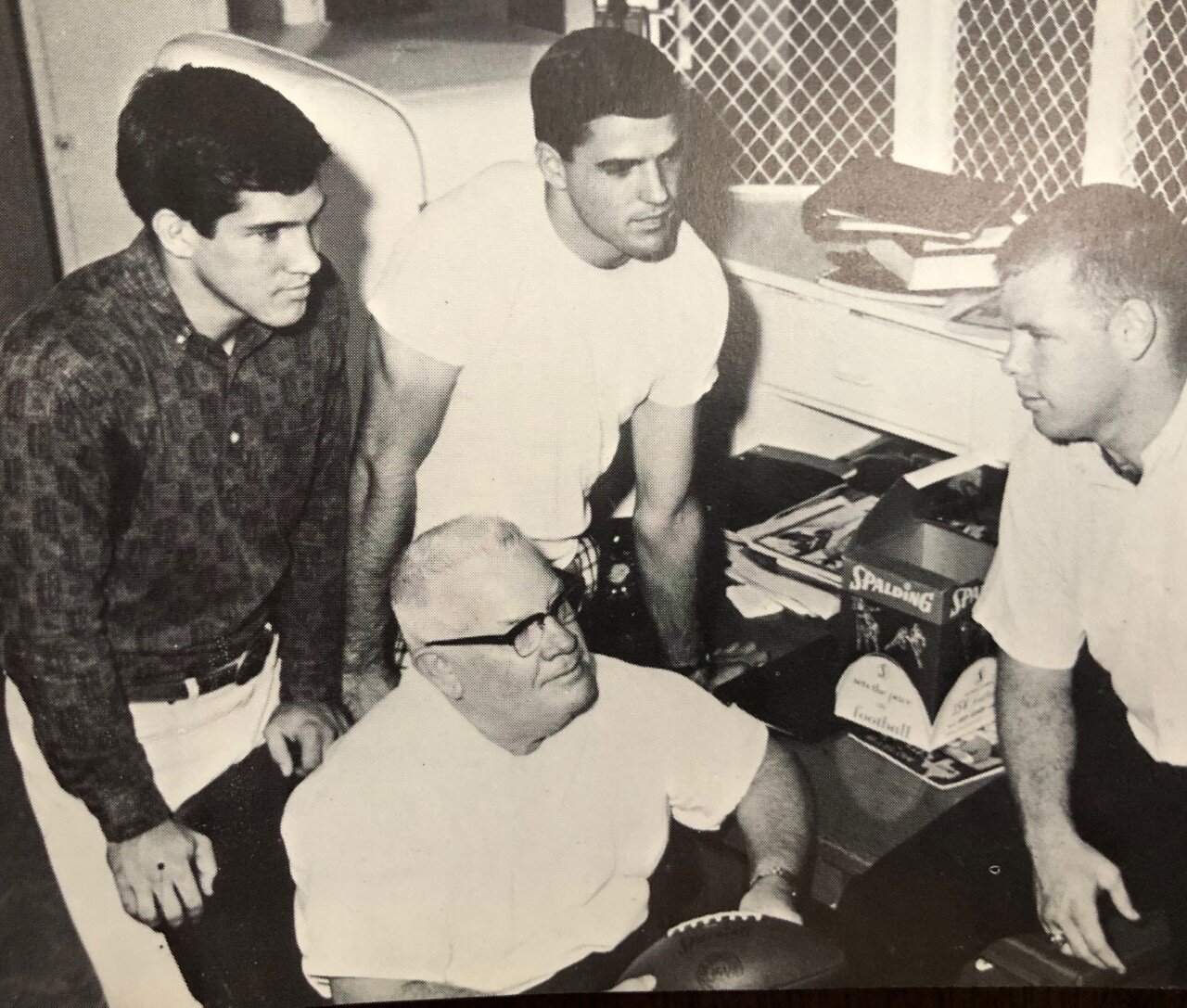West Texas Longhorn football heritage
“I was also fortunate that I was raised in a part of the world, West Texas, where individualism is strong.”
President George W. Bush



Wild As The West Texas Wind
by Larry Carlson ( lc13@txstate.edu )
It is a storied land, West Texas is. The region with no exact boundaries refuses to be fenced in by the imagination, and conjures images of the Texas of not so long ago, romanticized and criticized by outsiders longing to take a peek or to get the hell out, as fast as possible. It is a mystical place of Marfa Lights, Palo Duro Canyon, the limpid desert swimming hole at Balmorhea, windmills, piercing blue skies, cotton fields, endless technicolor sunsets and ruler-straight lonesome highways. The stars at night are, indeed, big and bright. Low humidity can make for lovely days with only the wind as ambient noise. It can be hellishly hot in Presidio and colder than the IRS in Dalhart, on the same day, with a blue norther on the way.
Choose your own artists for a West Texas soundtrack. I'll take Buddy Holly, Roy Orbison, Bobby Fuller, Waylon Jennings and Joe Ely, along with a stout foundation from Ernest Tubb and Bob Wills. But maybe you'll go with Butch Hancock, Pat Green, Delbert McClinton and Jimmie Dale Gilmore. There are dozens more, and they all sound good. Hell, if you're in the mood to cuss the local PTA, put on some Jeannie C Riley of Anson, aka Harper Valley.
Literary chroniclers of this majestic place of dust devils, derricks, barbed wire, booms, busts and chicken-fried steak include the legendary J Frank Dobie, Cormac McCarthy and native sons Larry McMurtry and Elmer Kelton. There's plenty of inspiration for writing about Comanches, the Goodnight-Loving Trail, Longhorns, mustangs, the law West of the Pecos, catclaw, mesquite and ocotillo.
It's been said that rugged West Texas is no country for old men. But it has long been the heartland of Texas high school football. It suits young men -- those willing to do what it takes -- quite well. West Texas boys are innately tough, rough, ready to be invincible. They are the original "Friday Night Lights" heroes.
A chosen few, the best of the best, even get to test their mettle at the collegiate level.
In the Southwest Conference's heyday from the 1940s through the '70s, West Texans made up a sizable portion of the Texas college football platter. These days, not so much. Recruiters focus on the expansive population centers of Houston and the DFW Metroplex. There just aren't that many high school blue-chippers in all of West Texas, comparatively. That said, this writer always enjoys reviewing history and spotlighting the best of Longhorn football. So I decided to become a one-man panel and select a Texas Longhorn all-time team of West Texans, starting with the Darrell Royal era of the late 1950s.
Feel free to agree or disagree with my choices. And maybe you don't go along with Wichita Falls or Brady, sometimes cited as the center of the state, as part of West Texas. That's okay. Just remember one thing next time you stare at stars, listen to the wind or long for an open road. West Texas is a state of mind.
TLSN TLSN TLSN TLSN
The West Texas Longhorn Starting Roster by Larry Carlson
OFFENSE
QB: Colt McCoy ('09) Tuscola (Jim Ned Indians)
RB Cedric Benson ('04) Midland (Lee Rebels)
RB Tommy Ford ('63) San Angelo (Central High Angry Orange Bobcats)
WR Roy Williams ('03) Odessa (Permian Panthers)
WR Jaxon Shipley ('14) Brownwood Lions
TE David Thomas ('05) Wolfforth (Frenship Tigers)
OL Jerry Sisemore ('72) Plainview Bulldogs
OL Bob McKay ('69) Crane Golden Cranes
C Perry McWilliams ('62) Plainview Bulldogs
OL Danny Abbott ('68) Amarillo (Tascosa Rebels)
OL Bryan Millard ('82) Dumas Demons
DEFENSE
DL Scott Appleton ('63) Brady Bulldogs
DL Tony Degrate ('84) Snyder Tigers
DL Leo Brooks ('69) Kermit Yellow Jackets
DL Knox Nunnally ('64) Midland Bulldogs
LB Glen Halsell ('69) Odessa (Permian Panthers)
LB Lance Taylor ('79) El Paso (Coronado Thunderbirds)
LB Britt Hager ('88) Odessa (Permian Panthers)
DB Jerry Gray ('84) Lubbock (Estacado Matadors)
DB Kenny Vaccaro ('12) Brownwood Lions/Early Longhorns
DB Fred Acorn ('83) Rotan Fightin' Yellowhammers
DB Ahmad Brooks ('01) Abilene Eagles
TWO-WAY STALWARTS
OE/DE Monte Lee ('60) Hale Center Owls
OG/LB Maurice Doke ('59) Wichita Falls Coyotes
SPECIALISTS
P Bobby Lilljedahl ('89) Abilene (Wylie Bulldogs)
K Eldon Moritz ('61) Stamford Bulldogs
Punt/Kick Returns
Greg Lott ('67) Lubbock Westerners
Jimmy Moore ('73) Clarendon Broncos
PRIME OFFENSIVE DEPTH
_____________________
QB Shea Morenz ('94) San Angelo (Central High Angry Orange Bobcats)
RB Billy Dale ('70) Odessa (Permian Panthers)
RB Terry Orr ('84) Abilene (Cooper Cougars)
RB Bobby Callison ('71) Abilene Eagles
WR Jimmy Moore ('73) Clarendon Broncos
WR Pat Kelly ('73) Amarillo Sandies
OL Ed Cunningham ('89) Fritch (Sanford-Fritch Eagles)
OL Mason Walters ('13) Wolfforth (Frenship Tigers)
PRIME DEFENSIVE DEPTH
DL Malcolm Minnick ('73) Wichita Falls (Rider Raiders)
DL Fred Currin ('74) Wichita Falls Coyotes
DL Dewey Turner ('82) Lubbock (Estacado Matadors)
DL Aaron Humphrey ('99) Lubbock (Monterey Plainsmen)
LB Rick Fenlaw ('76) Amarillo Sandies
LB Brian Jones ('90) Lubbock (Dunbar Panthers)
LB Mark Lang ('83) Iraan Braves
LB Tommy Woodard ('71) Abilene Eagles
DB Danny Lester ('70) Amarillo (Tascosa Rebels)
DB Taje Allen ('96) Lubbock (Estacado Matadors)
DB Tony Tillmon ('86) Borger Bulldogs
All the comments above are 1 of 2 parts of Larry Carlson celebrating West Texas football.
NOTES ON THE SELECTIONS
The great majority of the players cited here were all-conference selections while at UT. Many were also All-America picks and quite a few went on to play pro football. An even higher percentage utilized their college degrees to excel in a variety of career choices.
Colt McCoy was an easy selection as the QB. McCoy was not a prized recruit coming out of little Tuscola but he became college football's winningest starting quarterback while wearing the burnt orange. Currently a member of the Arizona Cardinals, McCoy has had the longest NFL career of any Longhorn signal-caller since the incomparable Bobby Layne.
Tommy Ford was a captain and All-America tailback for the '63 national champs, known as a gritty, ultra-dependable "three yards and a cloud of dust" runner. Cedric Benson, the first high school player to appear on the cover of Dave Campbell's Texas Football magazine, led UT in rushing all four years ('01-'04) at Texas, earning All-America honors and leading the Horns to their first Rose Bowl title.
Wide receivers Roy Williams and Jaxon Shipley rank only behind Jaxon's brother, Jordan, (he went to high school in the Central Texas town of Burnet) as the most prolific pass-catchers ever at Texas.
David Thomas is widely recognized as UT's best tight end. He memorably closed his UT career with ten catches in the national championship win over USC on Jan. 1, 2006, then was a productive NFL player and won a Super Bowl with the New Orleans Saints.
Performing the crucial work upfront, this O-Line of West Texans is headed by long-time NFL starters Jerry Sisemore, Bob McKay, and Bryan Millard. Danny Abbott was a two-time All-SWC choice in the late '60s and Perry McWilliams was immortalized when, on the defensive side, he recovered an OU fumble and scored the winning margin of points in a 9-6 victory over the Sooners in '62.
Bobby Lilljedahl, recruited to Texas as a rangy (6-5), big-armed QB, ended up as a standout punter and captain during the early David McWilliams coaching era of the late '80s when Texas was often forced to utilize his skills to negotiate field position. The placekicker is Eldon Moritz, an all-around player who lettered for the Longhorns in '55 and '56 under Coach Ed Price. Moritz then spent several years in the military but returned to UT and found his place with "an educated toe" as a kicking specialist for Darrell Royal's '61 team that won the Cotton Bowl and finished third in the country.
Return men will be Greg Lott and Jimmy Moore, both capable of breaking for long gains. Lott, a backup to Marv Kristynik and then Bill Bradley at quarterback, took the opening kickoff to the house for a TD against Texas Tech in the '66 conference opener in his hometown. Later, he became widely known as a love interest for Farrah Fawcett, while they were attending UT and again after she divorced actor Ryan O'Neal many years later.
Moore was a high school sprinter and made his way at WR in Austin in the wishbone era of limited passing. He more than earned his spurs, setting a Longhorn record by returning three punts for touchdowns in his career, a feat not bettered to this day.
The stop-'em side of the ball features arguably an even more star-studded lineup than the offense.
Scott Appleton won the Outland Trophy for the '63 national champions and might still be the greatest run-stuffing/pass-rushing combo in Longhorn lore. Tony Degrate, in 1984, took the Lombardi Award as the country's best defensive lineman. They're joined by "Large" (6-5, 245) Leo Brooks and the more modestly sized but gifted All-SWC performer, Knox Nunnally. Brooks played for the '69 national champs and Nunnally, who would become a prominent Houston trial lawyer, starred for the '63 national title team.
Two of the linebackers for this mythical West Texas All-Star team attended the same high school, almost two decades apart. Glen Halsell led Permian High of Odessa to its first state title in 1965, then became Coach Darrell Royal's "rolling ball of butcher knives" for the Longhorns. He was a captain of UT's 1969 national champs, earning All-America honors. Nicknamed "the Animal," Halsell once told Darrell Royal:: "Just keep those blockers off me, coach, and I'll make every tackle."
Britt Hager, another Panther, excelled for Fred Akers and David McWilliams in the 1980s, also earning All-America recognition. Almost 35 years after leaving the Forty Acres, Hager is still the Horns' all-time leading tackler. He played nine seasons in the NFL.
Lance Taylor
Rounding out the linebacking corps is Lance Taylor, arguably the most decorated high school product in El Paso history. Taylor was a consensus high school All-American at Coronado and made an impact as a freshman for DKR's final team. In 1977, Taylor became only the second of three Longhorn linebackers ever to earn all-conference honors as a soph, leading Texas to an 11-0 regular season. He had another stellar season as a junior but missed the final four games with a knee injury that would limit his career stats at Texas. Like Hager, Taylor is enshrined in the Texas High School Football Hall of Fame and recognized as one of UT's best linebackers.
Members of the secondary on this squad provide great validity for UT's intermittent claim as "DBU." Jerry Gray, Kenny Vaccaro, Fred Acorn and Ahmad Brooks all went on to cash NFL paychecks. Gray was twice an All-America pick at Texas where he still ranks third in career interceptions and is often remembered for chasing down Bo Jackson in a Longhorn victory over Auburn. Gray earned Pro-Bowl honors four times and is now an assistant coach for the Green Bay Packers.
Two members of this team were chosen as two-way starters from the one-platoon era of college ball.
Maurice Doke and Monte Lee exemplified the best of DKR's early squads. Doke was a 1959 All-American for Royal's first SWC championship team. He was recognized as an Academic All-American as well, and was a Rhodes Scholar candidate. He later served two terms in the Texas House of Representatives.
Lee was twice a Texas captain and went on to play four seasons in the NFL. He later displayed even more versatility as an educator in West Texas. Lee coached two state finalist teams in six-man ball at Cotton Center where he was superintendent first, then coach. He also drove the school bus. Monte Lee passed away at 83 in late August, just a few days before another football season began.
“The comments below were added by Billy Dale as an adjunct to Larry’s list. This list includes a few West Texas football players who either preceded the DKR era or who honored their West Texas heritage.”
Arlis Parkhurst
As the new Coach at Texas, Royal looked for players who understood that starting a winning tradition require bumps and bruises. He says, “Texas has to develop a football tradition. It had one once but lost it. When we get one, maybe we can stop the blood-letting up at Dallas (the O.U. game) and turn it into a good show.” Arlis Parkhurst fit the Royal profile of a football tradition builder.
Longhorn football Captain Arlis Parkhurst never forgot his West Texas roots. He established The Arlis Parkhurst Endowed Scholarship fund at the Texas Interscholastic League Foundation which provides tuition grants with an emphasis on trade and technical schools for students from smaller West Texas communities.
Randy Bishop
Randy Mack Bishop was born and raised in West Texas. Attending the University of Texas at Austin on a football scholarship, he graduated with a B.F.A. in studio art. Randy then went to the Art Center College of Design in Los Angeles, California, graduating with honors in illustration.
His work has been featured in Governing, Pockets, Texas Sporting Journal, Field & Stream, Outdoor Life, Fly Rod & Reel, and American Way. In addition, he has done work for such clients as Coopers-Lybrand, Exxon, Phillips 66, Neiman Marcus, Six Flags Over Texas, Haggar Slacks, Northern Telecom, Philadelphia Inquirer, Boston Globe, Baltimore Sun, Chicago Tribune, Cleveland Plain Dealer, Ottawa Citizen, and the San Francisco Chronicle.
His work has been recognized by such shows as the Society of Illustrators of Los Angeles, Dallas Society of Illustrators, Houston Society of Illustrators, and The Society of Newspaper Design. In addition, the Dallas Press Club presented him with its 1981 and 1993 Katie for Best Illustration Portfolio.
Eighty-five original art pieces were done while Randy was an illustrator for the Dallas Morning News reside in The Center for American History collection in Austin, Texas.
1893 - Addison “Ad” Day - Ballinger, Texas
1893- The teams were full of colorful characters, but none more so than the workhorse of the Texas offense, a young cowboy from Ballinger, Texas, named Addison "Ad" Day. Not only was Day the main rusher for the team, he was the first kicker in school history. It was Day who would set the tone as the game began.
Texas took the opening kickoff of the game and drove down the field using power plays. When Day pounded the center of the line right at the Dallas goal and the ball popped free, teammate James Morrison, a tackle, picked up the ball and ran in for the first score. When Ad Day kicked the ball through the goal posts for the two-point conversion, the young college kids had a 6-0 lead.
Dallas would never recover. Day scored another touchdown and kicked the ensuing goal, but by halftime, the Dallas Football Club had regrouped and cut the score to 12-10.
There were no penalties in those days for "unsportsmanlike conduct," and players regularly openly argued with officials, so much so that referee Fred Shelley of the Austin Athletic Club got enough of Dallas' bickering that he quit after the first half.
His fellow official (there were only two), umpire Tom Lake of the Fort Worth football team, recruited one of his teammates to be the referee for the final stanza.
But when the second half started, there was Addison Day again, pounding his way and finally running fifteen yards for a touchdown and kicking the goal for an 18-10 lead.
Peppy Blount - Big Spring, Texas
Peppy's book titled "Mamas, don't let your babies grow to play Football" is a fascinating read- profound and insightful- capturing Longhorn football's greatness after WWII from 1945-1951. Bobby Layne, Dick Harris, Hub Bechtol, D.X. Bible, Blair Cherry, Dick Harris, Tom Landry, Rooster Andrews, Ed Kelley, and many others rebuilt Longhorn football from the malaise of poor football in the 1930s.
After his years as a Longhorn, Blount made a living playing NFL football, officiating college and professional football games, practicing law, a judge, ranching, writing, and drilling for oil.
But it was as a Longhorn while on scholarship that Blount made Longhorn sports history. In 1946 Blount, as a starter for the Longhorns, was also a "principal" speaker on the high school speaking circuit. The SWC rule book said that only coaches can be a principal speakers in these events, so Coach Bible made Blount a member of the coaching staff even though Blount was a scholarship player.
In 1947 Blount won a seat in the Texas House of Representatives. SWC committee members received complaints about Blount and reviewed his eligibility status. The Texas Attorney General determined receiving income from the House of Representatives and financial support as a scholarship athlete was illegal, and Blount officially lost his scholarship.
BUT Coach Bible allowed Peppy Blount to continue to live in the athletic dorm and maintained his dining room privileges at no charge. The G.I. bill paid for Blount's tuition and books. Blount finished his college career with no scholarship, but most of the benefits.
Bud McFadin - Iraan , Texas
BUD MCFADIN 1948-1950 COLLEGE FOOTBALL HALL OF FAME INDUCTEE
The 225 pound Bud McFadin was a Longhorn from 1948-1950. He played both offense and defense and was the state of Texas boxing and wrestling champion. In 1949, he won All-America honors from the International News Service for his defensive skills. In 1950, the All-America Board, the Associated Press, United Press, INS, and Look magazine named him first-team All-American. He was the MVP of the 1951 Cotton Bowl, and conference MVP. In the Chicago Tribune All-Star game, he was voted Most Valuable Player and selected to the College Football Hall of Fame in 1983 and Hall of Honor in 1973.
He almost left Texas his freshman year because he missed his horse. Longhorn officials resolved this issue by moving Bud's horse to a location closer to Austin.
Tillman Holloway, who played for Texas from 2001 through 2003, is Bud's grandson. Bud remembers that during the college recruiting process Coach Buddy Jungmichel lived with his family for two weeks.
Professionally, Bud is one of the only football players who was All pro in both the NFL and AFL. Two times in the NFL and three times in the AFL.
Hub Bechtol - Amarillo, Tx.
STATISTICAL INFORMATION ABOUT HUB BECHTOL
Bechtol was the first consensus All-American from UT.
He actually started his college career at Texas Tech, but he joined the Navy during the war and after the war decided to attend Texas. He is one of only 2 players in the History of Longhorn Football to be named an All-American three times.
All-American and All-SWC from 1944-46
Led UT with seven touchdowns in 1945
Caught nine passes for 138 yards and was named Co-MVP in 1946 Cotton Bowl win vs. Missouri
Formed great passing combination with quarterback Bobby Layne
First-round draft pick of Pittsburgh Steelers
Played for NFL Baltimore Colts from 1947-49
Member of National Football Foundation Hall of Fame
Founder of Austin's little league baseball program
Member of the College Football Hall of Fame
Hubert Edwin "Hub" Bechtol was a college football player for the Texas Tech Red Raiders and the Texas Longhorns. He was a 3 Time All-American at The University of Texas at Austin in 1944, 1945, and 1946. He became the first Southwest Conference player to receive 3 All-American honors and this later led to his election to the College Football Hall of Fame in 1991.
Hub’s College Football Hall of Fame Ring.


























